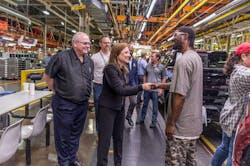In 2013, just months before she became CEO of General Motors, Mary Barra gave a commencementaddress to graduates at her alma mater, Kettering University. She emphasized the merits of hard work and tenacity.
“Don’t be content working around the edges of your profession,” she told the students. “Don’t wait to be invited to an important meeting. Don’t expect to be asked to work on critical assignments … Instead, speak up, volunteer, show your enthusiasm … Inspire people to join your team, and play hard as well.”
She talked about the importance of addressing problems head on, giving back to society, protecting the environment and building the next generation’s future.
These could be the tenets for Barra’s own 40-year career at GM, where she dove headlong into new challenges, from engineer to head of HR and then running global product development, with a bevy of other job titles in between.
As CEO, she has dealt with conflict and change in a forthright manner: For instance, in 2019, Barra made the unpopular decision to close five North American plants and lay off 6,000 workers, acknowledged the hardship on families, pledged to relocate or retrain all laid-off employees who wanted, and laid a clear path forward. Production workers went on strike for six weeks, and gained back some wages and kept their healthcare benefits. But the strike ended without GM fulfilling the union’s central demand of relocating jobs from Mexico to Lordstown, Ohio. Instead, Barra announced plans to co-build a non-union battery plant in Lordstown in partnership with LG.
“I think she took the right stance and ended up settling on probably the best deal that she could,” says Carla Bailo, president and CEO for the Center for Automotive Research. “I mean, she couldn’t roll over and just accept the demands that they were making, not with all the uncertainties that were in the market.”
Going back to the Kettering speech, focusing on change for the betterment of society has been Barra’s messaging around her plan to electrify GM’s entire vehicle portfolio within a decade. “We believe climate change is real, it’s a global concern and the best way to remove automotive emissions from the environmental equation is an all-electric zero emissions future,” she told a meeting of investors in February 2020.
Slow to Succeed
Why look at Mary Barra’s leadership, six years into her tenure as CEO? She was the first woman to lead a major automaker; that in itself raises her profile. A lot of women in leadership, silently or loudly, have an interest in seeing her knock it out of the park. “I think very, very highly of her,” says Sara Greenstein, CEO of Lydall, a $750 million manufacturer of specialty engineered products. Greenstein, like Barra with the United Autoworkers Union, was involved in union negotiations when she was a senior vice president at U.S. Steel. “I’ve obviously watched what she’s done and how she’s done it, and have a lot of respect for her. She has an innate way of leading in an inclusive manner— bringing a unique voice to the table and getting to an agreement that both sides can live with and still see some benefit from.”
Barra is also a visible role model, promoting STEM and encouraging girls to consider paths in engineering. In 2017, she was the highest paid CEO of the Detroit 3 automakers, with a salary of $21.96 million, and brought an affordable long-range electric vehicle (the Chevy Bolt) to market before Tesla (the Model 3).
And like another woman in a high-profile job, Michigan Gov. Gretchen Whitmer—she’s been a target of President Donald Trump’s tweets—and Trump makes it personal:
March 2020: As usual with ‘this’ General Motors, things just never seem to work out. They said they were going to give us 40,000 much needed Ventilators, ‘very quickly’. Now they are saying it will only be 6000, in late April, and they want top dollar. Always a mess with Mary B.”
March 2019: “Just spoke to Mary Barra, CEO of General Motors about the Lordstown, Ohio, plant. I am not happy that it is closed when everything else in our country is BOOMING. I asked her to sell it or do something quickly. She blamed the UAW Union—I don’t’ care, I just want it open!”
Barra’s response to the tweets was no response. “The best thing is not to reply,” says Bailo. “Don’t let them goad you on further. And then oftentimes the PR group pushed out the facts later.” Her communication style is collaborative; often, Barra delegates big announcements to her leadership team. “You see (GM Executive Vice President of North America) Steve Carlisle out there talking; she puts (GM President) Mark Reuss out where it’s appropriate,” adds Bailo. “She saves her speaking engagements for those things that are really important to her.”
Since Barra took the helm in 2013, GM is a viable company again, after the bailout and then an ignition crisis that fulminated in the early days of Barra’s leadership. And it’s preparing for the future in the sense that Barra announced GM’s shift from gas-powered to electric vehicles, and made some key movements in that direction. But if her vision is being realized, much of it is still behind the scenes. Yes, GM brought the Bolt to market in 2017, but few are buying it—Tesla sold more Model 3’s in one quarter than GM sold Bolts in a year—and if there’s an exciting GM electric vehicle in the wings, it’s a well-guarded secret.
Kicking off the 2014 Auto Show with Ford President and CEO Alan Mulally.
“I don’t think they’re succeeding yet,” says Scott Davis, chairman and CEO of Melius Research, an industrial equity research firm, and co-author of Lessons from the Titans, a book that examines key successes and failures of industrial companies including 3M, GE and Boeing. “It’s kind of status quo, fumbling along, paying the dividend, funding the pension. Not really playing offense yet.”
Angus Ward, CEO of digital solutions for Bearing Point//Beyond, a multinational consulting firm with automotive and industrial focus, says that GM has “ticked all the right boxes” by acquiring self-driving tech startup Cruise Automation and embarking on a shift to electric vehicles, but hasn’t been able to take its efforts to the bank. Even compared to other legacy automakers, “they don’t have a rich portfolio of EVs on the road,” he says. “But it’s [commanding] huge management attention—and a huge investment. The question is, will they deliver on the strategy?”
A big part of the EV race is who’s going to engineer and produce the low-cost battery, bringing the vehicle price down, and Ward is not sure LG is an innovative enough partner for GM to break out of the pack there. He’s also concerned that although GM has been very public about its EV strategy, it hasn’t been building a charging infrastructure like Tesla has. Also, EVs have a lot fewer spare parts to replace, and GM hasn’t said where it’s going to replace its considerable income from aftermarket parts and vehicle service.
Barra is a capable leader, but is she the right leader for GM going forward? What must she do to position the automaker, which organizationally still can behave like an old rattletrap, for a dynamic future?
A Lifer in the Role
Barra didn’t grow up on an automotive plant floor, but pretty close. Her father, Ray Makela, was a tool-and-die maker at the Pontiac plant for 39 years, and liked to tinker at home. Barra recently told a group of Girl Scouts that she would hang out with her dad at his workbench in the basement, “where he took things apart, and I put things back together.”
No sooner had she graduated from high school than her GM career began. Barra attended the General Motors Institute, now Kettering University, which cranks out high-level automotive engineers like West Point cranks out military leaders, and co-op-ed at GM (for a time, in the Pontiac plant where her father worked) during alternate semesters.
“When I was 18 years old, my friends were all working at fast-food restaurants, and as a Kettering student, I was applying engineering skills in a GM assembly plant,” she told the Kettering graduates. “That experience was absolutely invaluable for me. It gave me an early understanding of what it meant to be an engineer in the auto business. It served as an entry point in the industry, and it really gave me a leg up in the corporate world.”
A visit to the Fort Wayne Assembly plant, 2019.
Although Barra has been criticized for not gaining perspective from time spent working at another company, her broad experience at GM has given her a unique understanding of the inner workings of a vast, complex organization, says Tory Clarke, co-founder and partner of C-level recruiting firm Bridge Partners. “She comes to the table with as many different experiences from a professional perspective as one might see from somebody who’s been in four or five different organizations.”
A CEO from the tech world might bring change faster, says Sonita Lontoh, an industrial engineer by training who is now global head of marketing for 3D printing & digital manufacturing at HP, but having a disruptor at the helm could also send the institutional automotive expertise packing.
“I think you need the Mary Barra type of authentic servant leadership to lead a company like GM because it’s a legacy business with a certain Midwestern culture," Lontoh says. "Humility and authenticity resonate more with both the employee base and the community base—their DNA is not this kind of Silicon Valley disruptive, loud, boastful.”
About that humility and authenticity: At GM, Barra’s roles have included, in loose chronological order: hood and fender panel inspector (age 18), engineer in the Pontiac Fiero plant, executive assistant, internal communications associate, plant manager at the Detroit Hamtramck Assembly plant, and then executive roles in manufacturing engineering, human resources, and finally, in 2011, the lead product development role at GM.
Barra has said that when she took the HR role, she was unsure how it would help her career, but it ended up being a tremendous learning experience. Bailo, a fellow Kettering engineering alum who was head of human resources for Nissan in Japan before leading the company’s R&D in North America, had a similar experience of being thrown into the fire with HR. “That was the most learning I’d ever experienced in my engineering life,” she says. “I’ve never, ever spoken badly about an HR person again. I learned that people are very difficult. I thought in HR, I could just deal with the top people to do succession planning, do organizational development, think about training needs, but I got so many horrible situations with people losing their temper or throwing things.
“I think what it does for a CEO is, it makes you realize that every person is not homogeneous; everyone has different needs, everyone reacts differently to different motivations. So the organizational development, the ability to negotiate—I cannot tell you how important that is.”
As global head of product development, Barra was known for streamlining approval processes that could get bogged down on minute details, and for holding engineering teams to launch schedules. Some 20 senior engineering executives were either reassigned or sent sailing into early retirement during the transition to her leadership.
“She’s bringing order to chaos,” then-GM vice chairman Steve Girsky, now chairman of Nikola, told Automotive News at the time. “And she does it in a calm, direct way.”
Barra’s wins in product development during that time included the 2013 Cadillac ATS receiving North American Car of the Year at the North American International Auto Show. She was on the electric fast track then, promising in 2012 up to 500,000 vehicles with some form of electrification by 2017, with a focus on plug-in technology.
“It became very clear post-bankruptcy that she was the CEO-elect,” says Bailo. Barra was with then-GM CEO Dan Akerson, who had already announced his retirement, at almost every appearance he made. “There had yet to be a woman that had cracked that ceiling in the automotive industry. And in fact, women are still not represented properly in management in any automotive company. So for those of us that had risen in our careers, to see a woman actually get that position was just—it was wonderful. I think I spent all day long just chatting with other colleagues about how great this was and what it could do for women in the industry.”
Barra brings an important consistency and stability to GM, observes John Cardwell, global account manager for automotive for steel manufacturer ArcelorMittal, supplier to GM and other automakers. “I think as a CEO she’s quite egoless; that’s very powerful,” he says. “That doesn’t mean she’s not tough. That doesn’t mean she can’t make hard decisions. But what that does mean is she can be objective. I think she’s done a very good job of establishing a leadership team that reports to her, that is well-aligned in terms of what GM is trying to accomplish. But they’re not a bunch of yes men and women who tell her what she wants to hear.”
Crisis, Crisis, Crisis
You can’t critique Barra’s tenure at GM without looking at the company she inherited. She took the helm when GM was still emerging from its $49.5 billion bailout from the U.S. Treasury (which in the end cost taxpayers about $10 billion) and facing a firestorm of legal and public reprisals for 12 deaths linked to faulty ignition switches in smaller vehicles that the company knew about 10 years before.
Two months into her new role, Barra, who reportedly did not know of the ignition defect until 16 days after she became CEO, was testifying before Congress on the matter.
“Many of us thought, ‘Oh my God, they left her with this nightmare of a situation’” says Bailo, referring to women in leadership roles who were watching Barra closely, because they saw her success as their success. “We thought, ‘Is she going to survive it?’”
Testifying before the U.S. House on the ignition switch scandal, 2014.
Barra began her testimony with an apology to the families who lost loved ones and promised to get to the bottom of the coverup with an investigation by former U.S. attorney Anton Valukas. “The facts will be the facts,” she said. “Once they are in, my management team and I will use his findings to help assure this does not happen again. We will hold ourselves fully accountable.”
Although the ignition crisis resulted in 2.6 million recalled vehicles and nearly $600 million in victim compensation, Barra won points for acting swiftly and decisively, being upfront about the gravity of the situation and acknowledging wrongdoing without reservation or backpedaling. “Just saying, ‘We’re going to fix this, and I’m going to fix the company. And we’re going to admit we did something wrong,’ and that was much different than I think we’ve seen a lot of executives handle some of the stories that happened at VW and Daimler and some of the others,” Bailo says. “It just demonstrated her fortitude and ability to handle that kind of pressure and crisis.”
In addition to mismanagement, irrelevance and scandal, Barra inherited a company culture that revolved around big egos and expense accounts, far corners of the business that operated like their own little fiefdoms, and a resistance to change.
The financial crisis of 2008-2009, which resulted in 47,000 layoffs, had taken a lasting cultural toll on a company that had a reputation for operational excellence but was outdated in other areas, says Davis. “When companies fall into financial problems and resort to a lot of layoffs, the culture can break down, and that culture then needs to be rebuilt,” he says. “It’s really important that the people that are remaining understand the honest story there—why did we have to make these difficult decisions? Why do we think we’re in a good position to not have to do that again? People perform better when the company gives a flying you know what about them.”
Davis says Barra has had to focus on rebuilding, rather than innovating, so the result has been an electric vehicle lineup that hasn’t jazzed anyone—and to be fair, none of the legacy automakers have been able to wow consumers with electric vehicles, unless they’re working in the luxury space. “It gets hard to transition from a culture that’s innovating incrementally, or working with suppliers to make small improvements every year, to doing something completely different—a clean sheet of paper, we’re going to build an electric vehicle from scratch,” he says. “Not just General Motors but the rest of the auto industry has really struggled with that clean-sheet concept. Because if your engineers have been doing something a certain way for their entire careers, having them do it completely differently almost requires hiring different people.”
Davis says it’s significant but not a deal-breaker for Barra’s legacy that the stock price hasn’t budged much during her tenure.
“There is a certain point where Wall Street gets very impatient,” says Davis. “And when investors get impatient, they push harder, and when they push harder, sometimes it forces you to do things you don’t want to do. It takes 10 years to make significant change—and for Mary it may take 10 years—and I don’t think investors truly understand how long it takes. Typically what happens is, you’ll look back and say, ‘Wow, that CEO did an amazing job’ or ‘Oh my God, what a disaster.' You know, when you think about the [former GE CEO] Jeff Immelt story at GE, even four or five years ago, there were people that thought he was good. It wasn’t until he was fired and their earnings numbers missed, that you realized the new products were not working and that the Alstom acquisition was a disaster. So it’s very hard to say in real time.”
Still, the wheels are in motion for change. Before COVID, GM was showing solid earnings despite the 2019 strike. It announced a $2.2 billion investment in its Detroit-Hamtramck plant to make a range of electric trucks and SUVs, and a partnership on AV technology with Honda. A partnership with now-embattled electric truck startup Nikola gives GM 11% ownership in the company and a spot on its board of directors, in exchange for GM supplying batteries and fuel cells. Barra has also trimmed GM to a more manageable size, exiting the business in Europe, Russia, and India.
“I think Mary’s done a really good job of not trying to pretend that things are great,” adds Davis, who sees her as a transitional leader, not a transformative one. “She’s done a very good job of being very clear that the challenges have not been met yet.” He doesn’t sense that his Wall Street clients are disappointed in Barra, “just as much as disappointed in the entire auto industry and not being able to catch up to Tesla.”
Bailo says that Barra has opened the door for transparency and better communication, but there’s work yet to be done. “Culture is really hard to change in a company that old,” she says. “It’s more than hard to change. I think she has opened the door to be more transparent, to communicate better. But I think until the workforce shifts, they’re still a little bit of the old GM. You can see it in some of the things that are said and some of the actions that are taken. For example, the story that just came out that the Cadillac dealers all have to invest X amount of money for EVs, that’s a big ask for dealers when they’re in the middle of a crisis.
“All facets of the business have to catch up to the way she’s thinking and that company is so big, that she has to have everybody on her leadership team aligned with her all the time. And that's a tough job for anybody."
Main photo: Barra, center, volunteering with employees in Detroit’s Cody Rouge community.








